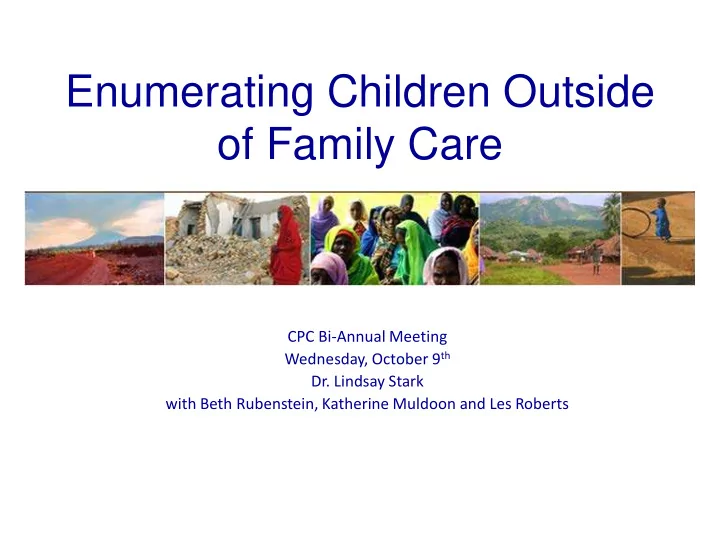

Enumerating Children Outside of Family Care CPC Bi-Annual Meeting Wednesday, October 9 th Dr. Lindsay Stark with Beth Rubenstein, Katherine Muldoon and Les Roberts
• Commissioned by USAID’s Center of Excellence on Children in Adversity in support of Objective 2 of the APCA • Intended to help national actors enumerate children outside of family care and monitor trends in this population over time.
Goals of Surveillance Comprehensive surveillance systems for children outside of family care can: • Identify children outside of family care in real- time; • Link them to opportunities for placement in nurturing families; and • Measure and monitor trends of their numbers nationally to document progress towards reduction goals.
Methods considered Respondent driven sampling Capture- Time location recapture sampling Head count Network plus ‘decoys’ sampling Head count Census
Sentinel Surveillance • Requires fewer resources than population-based surveillance; • Has been shown to be an efficient and effective approach for monitoring trends over time (e.g. HIV) • Requires careful selection in order to produce national composites
Guidelines Include… • An enumeration strategy for children in institutions • An enumeration strategy children living on the street in towns and rural areas • An enumeration strategy for children living on the street in large cities • A cohort reconstruction methodology to estimate the relative magnitude of various categories of children outside of the family • Guidance on how to extrapolate findings to the national level
Children on the Street
Objectives • Estimate the point prevalence of children living on the street in select sentinel surveillance areas, stratified by age and gender.
Inclusion criteria • Whether a given child is seen or recorded sleeping on the street or in a shelter during the designated enumeration night or; • Meets the CDC criteria of “any child less than 18 years of age who is found on the street who meets at least one of the following criteria: • Does not attend school regularly; • Lives out of family care; • Lives full or part-time on the street; • Self-identifies as a street youth or street child.”
Enumeration Strategy Towns and Rural Areas Constructed Shelter Count Street Count Social Network Capture-Recapture Capture-recapture: an analytic process that calculates a more robust total estimate by mathematically adjusting for overlap from two independent lists or “captures”.
Shelter Count 1. Develop comprehensive list of shelters 2. Seek consent from shelter supervisor 3. Acquire count (by age and sex) of all children sleeping in the shelter that night 4. Record identifying information of children ages 14-17 5. Select sub-sample of 14-17 year olds for follow up interview to develop a listing of those children’s social networks
Street Count 1. Establish referral options 2. Divide sentinel site into discrete geographic sub-units 3. Determine nighttime time interval for the count (e.g. 2am-4am) 4. Approach every child and ask their age and whether they would like safe shelter for the night 5. Record age and sex for every child <14 6. For children 14-17, seek consent for a brief interview 7. For those who consent, collect identifying information 8. Select sub-sample of 14-17 year olds for follow up interview to develop a listing of those children’s social networks
Constructed Social Network 1. Select a sample of 14-17 year olds from street and shelter counts 2. Select sample of 14-17 year olds through time location sampling 3. Informed consent 4. Children briefly interviewed about themselves 5. Children briefly interviewed about eight of their peers between the ages of 14 to 17 years, who meet the other CDC-developed case criteria for children living on the street and sleep within the bounds of the sentinel site
Capture-recapture for towns and rural areas List A: Shelter count + street Constructed count Social Network List B: Constructed social network (i.e., children Street Count Shelter Count named by contacts from the social network sample) List C: Overlap between List Interviewed for Network Sampling A and List B
Capture-recapture (cont.)
Limitations • Possibility of an incomplete sampling frame (i.e. If shelters or streets are missed) • Nighttime mobility • Two lists may not be fully independent
Ethics • Inclusion of minors • Support and referral mechanisms • Risks and benefits • Safety of data collectors
Next Steps • Pilot the enumeration strategies in a few countries; • Refine methodologies; • Build the capacity of national governments to conduct routine surveillance of children living outside of family care; • Identify areas for further research that will improve outcomes of children currently living or vulnerable to being outside of family care.
Thank you
Recommend
More recommend